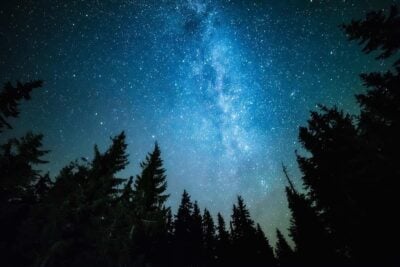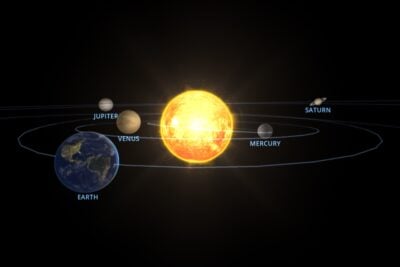
Where to see the Geminid meteor shower in 2023
Latest news 5 minute read
Read article
The effects of light pollution on how we see night-time skies are dramatic. From a light-polluted town or city, it’s possible to see perhaps 200 stars; however, from a dark sky site, it’s possible to see as many as 3000 stars without any visual aid on a moonless night.
You can often readily see the effects of light pollution; some nights, the skies glow orange caused of the inefficient sodium-vapour street lights illuminating the clouds above. Light dilutes the skies washing starlight out on clear nights, and fewer stars are visible.

Recent studies have identified light pollution as having a growing significant impact on our environment. Adverse effects have been found not just in humans, where light affects sleep patterns and can even lead to cancers, but in nature too.
For example, have you recently heard a bird singing in the middle of the night? While LED lighting offers better efficiency, bright white light leads to confusion in both nocturnal and diurnal (daytime) animal behaviour. Indeed, light pollution is causing adverse knock-on effects throughout nature’s ecosystems.

There is a simple rule to follow — use light only where and when you need it.
Consider your impact on your local environment, in particular at home but also your place of work. For example, does the floodlight in the back garden need to illuminate your neighbour’s upstairs windows or roof? Should it always be left on, or only when people need it?
Adjusting fittings to direct light downwards is a quick and easy fix, and most lights can be put on a timer or fitted with an inexpensive motion detector.


See for yourself just how bad (or good!) light pollution levels are near you on our interactive light pollution map, which comes in especially handy if you are planning a stargazing trip and looking for dark locations!
Perhaps the most significant action you can take is to ask your MP to join the All Party Parliamentary Group for Dark Skies. Our website makes it easy for you to do so! Simply enter your postcode to find your MP and submit our pre-populated form to send them an email with your instructions!
All locations on this website have been categorised based on their estimated level of light pollution, giving you an approximate indication of how dark the local sky conditions might be on a moonless night. Note that when there is a bright moon in the sky, states will be similar to “urban” no matter the location.
 Dark sites represent the very darkest of locations and are therefore the very best places to go stargazing. From these sites, the brighter and darker regions of the Milky Way are visible, and the glow of light pollution is limited to the distant horizon. Many deep-sky objects such as galaxies and nebulae reveal good detail when observed through a telescope.
Dark sites represent the very darkest of locations and are therefore the very best places to go stargazing. From these sites, the brighter and darker regions of the Milky Way are visible, and the glow of light pollution is limited to the distant horizon. Many deep-sky objects such as galaxies and nebulae reveal good detail when observed through a telescope.
 Rural locations will give excellent views of the brighter regions of the Milky way especially directly above and away from the horizon where there can be some effects of sky-glow from local light pollution sources. The brightest deep sky objects reveal good detail and look fantastic through a telescope.
Rural locations will give excellent views of the brighter regions of the Milky way especially directly above and away from the horizon where there can be some effects of sky-glow from local light pollution sources. The brightest deep sky objects reveal good detail and look fantastic through a telescope.
 Despite more localised light pollution from nearby sources semi-rural locations still offer fantastic views of the Milky Way if shielded from direct light. Deep sky objects are observable, although they lose detail due to sky-glow.
Despite more localised light pollution from nearby sources semi-rural locations still offer fantastic views of the Milky Way if shielded from direct light. Deep sky objects are observable, although they lose detail due to sky-glow.
 In these areas the effects of light pollution really become noticeable with faint views of the Milky Way being limited to those who know where to look. Suburban locations still offer the opportunity to observe objects through telescopes; deep sky objects are readily visible, although it can be difficult to discern much detail. Brighter objects such as the moon and planets not as much affected by light pollution look fantastic through a telescope.
In these areas the effects of light pollution really become noticeable with faint views of the Milky Way being limited to those who know where to look. Suburban locations still offer the opportunity to observe objects through telescopes; deep sky objects are readily visible, although it can be difficult to discern much detail. Brighter objects such as the moon and planets not as much affected by light pollution look fantastic through a telescope.
 Unfortunately urban areas are all too common! The Milky Way is not apparent, and few stars can be seen compared to a dark site. However, with visual aids such as binoculars or a telescope, some of the brightest objects can be seen, albeit with little detail. Even with high light pollution levels, planets and the moon still look awesome through a scope!
Unfortunately urban areas are all too common! The Milky Way is not apparent, and few stars can be seen compared to a dark site. However, with visual aids such as binoculars or a telescope, some of the brightest objects can be seen, albeit with little detail. Even with high light pollution levels, planets and the moon still look awesome through a scope!
Our most recent astronomical articles...

Latest news 5 minute read
Read article
Latest news 4 minute read
Read article
Latest news 5 minute read
Read article
Latest news 2 minute read
Read article
Latest news 1 minute read
Read article
Latest news 2 minute read
Read article